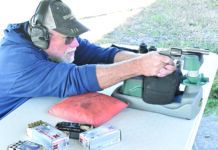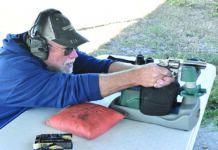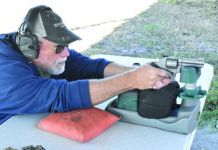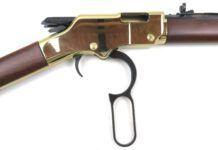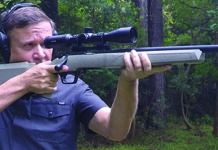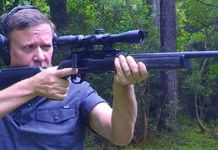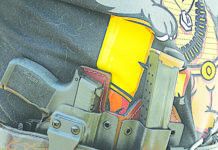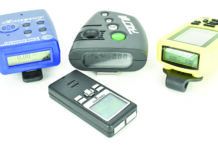To the basic rifle price ($2,500) must be added the prices for the gorgeous McMillan M3A stock ($600), the ARMS steel scope mount ($150), extended rail ($100), bipod ($70), swivel package ($100), and a leather sling ($50). There was also a Krieger barrel ($200). The total package, less scope but with mount and rings, came to $3,770. With the Leupold scope, the tag would be about $4,620 as tested. We got our prices out of the maker’s catalog and may have missed a few things, so it’s best to contact Fulton for an exact quote on your needs. We had the loan of some scopes with state-of-art add-ons set up specifically for the M14 that bear close scrutiny.
Serious potential users of this rifle need to know of the existence of these amazing systems. These included the Leupold 3.5-10X Long Range Tactical Mil-Dot scope (about $850) with Night Quest PVS-14 Third Generation NV (night vision) WeaponSight, $3,400, and laser IR (infra-red) source for seeing things at least 500 yards away in zero-light conditions. Fulton can probably supply all the night-vision equipment you might need, as well as every imaginable part and accessory for the M14 rifle, for the Garand, M1 Carbine, AR-15, and for several other rifles. Please note that some products are available only to law-enforcement or military personnel.
Fulton’s Peerless rifle was easily the most impressive-looking of this test trio. When we pulled it out of its box, we were struck by its purposeful beauty. Everything about the rifle was flat black except for the exposed Krieger stainless barrel, which was in the white, with a decent but not glaring polish. The McMillan M3A stock felt just great. Its pistol grip was acutely angled to give near-perfect trigger control. The forend and pistol-grip areas were roughened to act like checkering. The ambidextrous, adjustable cheek piece gave soft comfort to the face. The length of pull was adjustable by means of inserts, and the butt was backed by a rubber pad that gripped the clothing to keep the rifle in place. Even the sling swivels were to some extent ambidextrous.
There were very useful QD sling-attach points on the left side of the stock, and also two more standard-type swivels beneath the stock. Lefties would be completely at home with this setup. Although the rifle had a national-match front sight and what appeared to be a standard rear aperture, the scope mount interfered with them and we didn’t try them. The rifle also had a modified mil-spec muzzle brake without bayonet lug.
The rifle was built with some GI parts, and came with NM gas cylinder and spring guide, polished gas piston, recoil buffer, match-trigger mods, and a delightful book, The M14 Owner’s Guide, by Duff and Miller. This hand-build rifle included a 30-day money-back guarantee if the customer does not like anything — anything at all — about the rifle, and a lifetime warranty on manufacturing defects. With its Krieger barrel, the rifle was guaranteed to shoot under 1 MOA. Fulton used its new rear-lugged match receiver for this rifle, the receiver now being made specifically for Fulton Armory to owner Clint McKee’s exact specifications. Fulton also has a new standard M14 receiver for all its normal M14 configurations. The rear lug was secured to the stock by a bolt passing upward through the stock just above the trigger group.
With the bipod and big (beneath the forend) barrel, this was a heavy rifle. Without scope, it weighed 14.2 pounds. The static balance was right at the front of the receiver. Even with the night-vision scope, 3.5-10X Leupold, and infra-red laser mounted, the rifle’s fine balance belied its rather great weight of 17.2 pounds, and we felt like we could do good work with it offhand, as long as our arms held out. The trigger pull was two-stage, taking just over three pounds for the first stage, and breaking absolutely cleanly at 4.9 pounds with great consistency, something we rarely see on test rifles.
We found we could not shoot the rifle with the night-vision device attached in bright daylight (with the scope cover closed), but could do so on heavily overcast days. However, everything was rendered in green, not the best setup for day-to-day use. Removing the NV scope required about a second, flipping open the clamp device and pocketing the tiny (though costly) Night Quest PVS-14 scope.
The scope mount was the Swan ARMS M21/M14 setup, which, if not as stout as the Brookfield, seemed to be at least in the same ballpark for strength. It was made of steel, and had a support screw that bore against the front action ring, similar to the Brookfield setup. The mount bolted to the receiver, again like the Brookfield. The bolt required a 3/8-inch wrench, not just a screwdriver. Atop this mount was an extended rail, the aluminum Swan “Sleeve,” which ran halfway up the forend cover. It gave instant mounting options to a vast variety of M14/M21 accessories. It also extended the mounting stance of the Leupold scope, which attached via ARMS QD clamps and steel rings. This scope setup was versatile, strong, adaptable for quick changes, and effective for this particular rifle. The scope setup would be ideal on any sniper rifle, we felt, but on the M14 platform it seemed to make a whole lot of sense. The downside is that the complete rifle and all the NV scope stuff would have a price tag close to ten grand.
We do not think this scope setup, with laser IR and night vision, would be useful to most hunters, unless they were after specific dangerous predators and had to hunt them at night. Law enforcement and military personnel would be well served, however.
We fired the rifles (all three) with two types of match ammunition by Federal and Winchester, and included a 150-grain Barnes X-Bullet load by PMC Eldorado. The Fulton Peerless shot about as predicted. It was a 1 MOA rifle with Federal Gold Medal Match ammunition, and not far off with the other two types. Our best group was 0.5 inch with PMC Eldorado, though that averaged 1.2 inch for all shots. Worst average groups were with Winchester Supreme Competition, at 1.5 inch on average. We noted a distinct improvement in grouping ability the more we fired this brand-new rifle, so expect things would get better as everything settles in. The rifle was crisp in its action, and smoothed up to be even slicker after a few shots.
The thumbscrew that supported the rising cheek piece was reluctant to stay tight unless we really snugged it, something to be aware of. Another thing we noted about all three rifles was that the mag wells were very tight on the mag sides. The mags didn’t go in nearly as easily as they do on one of our shooters’ personal M14, which doesn’t have a match stock. It would seem all three makers don’t want the magazine to shake as the bullet leaves.
There was a feel in firing the Fulton Peerless that the other rifles didn’t have, which we find difficult to put into words. It may have come from the sound of the bolt closing in its locking recesses, or the buffer, or the way the parts all worked in precise unison, or the composition or makeup of the stock itself. But we liked the feel of this rifle immensely. It looked great, was comfortable, was clearly set up by shooters for shooters, and did everything we expected of it.


